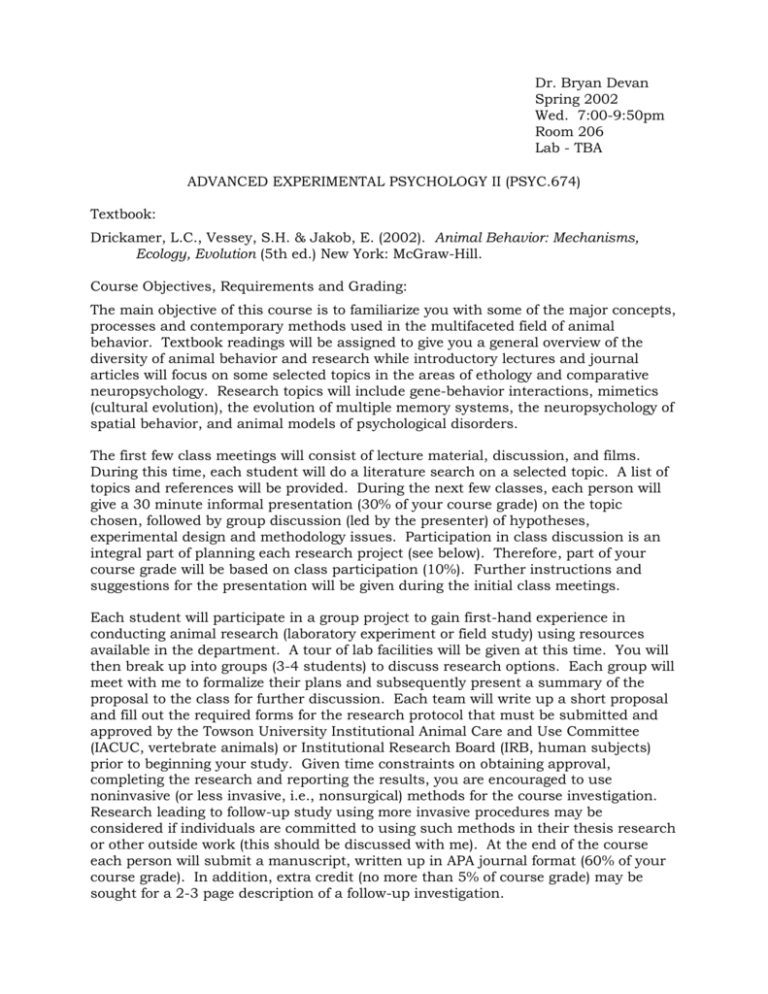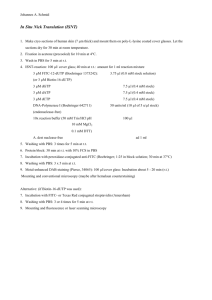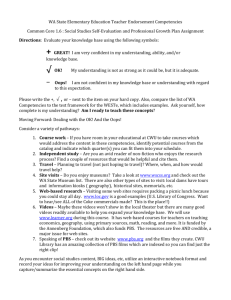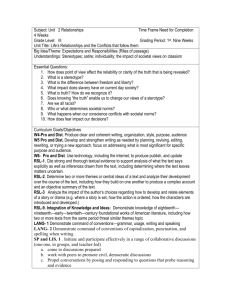2002 syllabus - Towson University
advertisement

Dr. Bryan Devan Spring 2002 Wed. 7:00-9:50pm Room 206 Lab - TBA ADVANCED EXPERIMENTAL PSYCHOLOGY II (PSYC.674) Textbook: Drickamer, L.C., Vessey, S.H. & Jakob, E. (2002). Animal Behavior: Mechanisms, Ecology, Evolution (5th ed.) New York: McGraw-Hill. Course Objectives, Requirements and Grading: The main objective of this course is to familiarize you with some of the major concepts, processes and contemporary methods used in the multifaceted field of animal behavior. Textbook readings will be assigned to give you a general overview of the diversity of animal behavior and research while introductory lectures and journal articles will focus on some selected topics in the areas of ethology and comparative neuropsychology. Research topics will include gene-behavior interactions, mimetics (cultural evolution), the evolution of multiple memory systems, the neuropsychology of spatial behavior, and animal models of psychological disorders. The first few class meetings will consist of lecture material, discussion, and films. During this time, each student will do a literature search on a selected topic. A list of topics and references will be provided. During the next few classes, each person will give a 30 minute informal presentation (30% of your course grade) on the topic chosen, followed by group discussion (led by the presenter) of hypotheses, experimental design and methodology issues. Participation in class discussion is an integral part of planning each research project (see below). Therefore, part of your course grade will be based on class participation (10%). Further instructions and suggestions for the presentation will be given during the initial class meetings. Each student will participate in a group project to gain first-hand experience in conducting animal research (laboratory experiment or field study) using resources available in the department. A tour of lab facilities will be given at this time. You will then break up into groups (3-4 students) to discuss research options. Each group will meet with me to formalize their plans and subsequently present a summary of the proposal to the class for further discussion. Each team will write up a short proposal and fill out the required forms for the research protocol that must be submitted and approved by the Towson University Institutional Animal Care and Use Committee (IACUC, vertebrate animals) or Institutional Research Board (IRB, human subjects) prior to beginning your study. Given time constraints on obtaining approval, completing the research and reporting the results, you are encouraged to use noninvasive (or less invasive, i.e., nonsurgical) methods for the course investigation. Research leading to follow-up study using more invasive procedures may be considered if individuals are committed to using such methods in their thesis research or other outside work (this should be discussed with me). At the end of the course each person will submit a manuscript, written up in APA journal format (60% of your course grade). In addition, extra credit (no more than 5% of course grade) may be sought for a 2-3 page description of a follow-up investigation. Reading Assignments Topic: Ethology and Comparative Psychology: Introduction and Overview Week Approx. date 1 Jan. 30 2 Feb. 6 Reading 1. Drickamer et al., Chapters 1, 2 and 3 2. Mayr, E. (1961). Cause and effect in biology. Science, 134, 1501-1506. 3. Platt, J.R. (1964). Strong inference. Science, 146, 347353. 4. Dewsbury, D.A. (1999). The proximate and the ultimate: past, present and future. Behavioural Processes, 46, 189-199. 5. Mayr, J.R. (2000). Darwin's influence on modern thought. Scientific American, 283, 78-83. Evolution, Genes and Memes 3 Feb. 13 1. Drickamer et al., Chapters 4, 5 and 6 2. Ayala, F.J., & Fritch, W.M. (1997). Genetics and the origin of species: An introduction. Proceedings of the National Academy of Sciences, USA, 94, 7691-7697. 3. Horgan, J. (1993). Eugenics revisited. Scientific American, 268, 122-131. 4. Blackmore S. (2000). The power of memes. Scientific American, 283, 64-6, 68-71, 73. 5. Ross, S.E. (1999). "Memes" as infectious agents in psychosomatic illness. Annals of Internal Medicine, 131, 867-871. 6. Miklósi, Á. (1999). The ethological analysis of imitation. Biological Reviews of the Cambridge Philosophical Society, 74, 347-374. Neural and Hormonal Influences 4 Feb. 20 1. Chaps. 7 and 8 2. Duchaine, B., Cosmides, L., & Tooby, J. (2001). Evolutionary psychology and the brain. Current Opinion in Neurobiology, 11, 225-230. 3. Snyder, S.H., & Ferris, C.D. (2000). Novel neurotransmitters and their neuropsychiatric relevance. American Journal of Psychiatry, 157, 17381751. 4. Sapolsky, R.M. (1994). Individual differences in the stress response. Seminars in the Neurosciences, 6, 261-269. 5. Sapolsky, R.M. (1999). Glucocorticoids, stress and their adverse neurological effects: relevance to aging. Experimental Gerontology, 34, 721-734. Learning, Memory and Spatial Navigation 5 Feb. 27 1. Chaps. 11 and 13 (pp. 228-237) 2. Maguire, E.A., Burgess, N., Donnett, J.G., Frackowiak, R.S.J., Frith, C.D., & O'Keefe, J. (1998). Knowing where and getting there: A human navigation network. Science, 280, 921-924. 3. Devan, B.D., Goad, E.H., & Petri, H.L. (1996). Dissociation of hippocampal and striatal contributions to spatial navigation in the water maze. Neurobiology of Learning and Memory, 66, 305-323. (skim) 4. Capaldi, E.A., Robinson, G.E., & Fahrbach, S.E. (1999). Neuroethology of spatial learning: The birds and the bees. Annual Review of Psyhology, 50, 651-682. 5. Devan, B.D., & McDonald, R.J. (2001). A cautionary note on interpreting the effects of partial reinforcement on place learning performance in the water maze. Behavioural Brain Research, 119, 213-216. 6. Devan, B. D., Petri, H. L., Mishkin, M., Stouffer, E. M., Bowker, J. L., Yin, P. B., Buffalari, D. M., & Olds, J. L. (in press). A room with a view and a polarizing cue: Individual differences in the stimulus control of place navigation and passive latent learning in the water maze. Neurobiology of Learning and Memory. Biological Rhythms 6 Mar. 6 1. Chap. 9 2. Turek, F.W., Dugovic, C., & Zee, P.C. (2001). Current understanding of the circadian clock and the clinical implications for neurological disorders. Archives of Neurology, 58, 1781-1787. 3. Louie, K. & Wilson, M.A. (2001). Temporally structured replay of awake hippocampal ensemble activity during rapid eye movement sleep. Neuron, 29, 145-156. 4. Devan, B.D., Goad, E.H., Petri, H.L., Antoniadis, E.A., Hong, N.S., Ko, C.L., Leblanc, L., Lebovic, S.S., Lo, Q., Ralph, M.L., & McDonald, R.J. (2001). Circadian phase-shifted rats show normal acquisition but impaired long term retention of place memory in the water task. Neurobiology of Learning and Memory, 75, 51-62. (skim) Sexual Dimorphism 7 Mar. 13 1. Maguire, E.A., Burgess, N., & O'Keefe J. (1999). Human spatial navigation: Cognitive maps, sexual dimorphism and neural substrates. Current Opinion in Neurobiology, 9, 171-177. 2. Kinsley, C.H., Madonia, L., Grifford, G.W., Tureski, K., Griffin, G.R., Lowry, C., Williams, J., Collins, J., McLearie, H., & Lambert, K.G. (1999). Motherhood improves learning and memory. Nature, 402, 137138. 3. Astur, R.S., Ortiz, M.L., & Sutherland, R.J. (1998). A characterization of performance by men and women in a virtual Morris water task: A large and reliable sex difference. Behavioural Brain Research, 93, 185-190. 4. Sandstrom, N.J., Kaufman, J., & Huettel, S.A. (1998). Males and females use different distal cues in a virtual environment navigation task. Cognitive Brain Research, 6, 351-360. 5. LeVay, S., & Hamer, D.H. (1994). Evidence for a biological influence in male homosexuality. Scientific American, 270, 44-49. 6. Byne, W. (1994). The biological evidence challenged. Scientific American, 270, 50-55. Reproduction, Mating Systems and Parental Care 8 March 20 1. Chaps. 17 and 18 2. Gil, D., Graves, J., Hazon, N., & Wells, A. (1999). Male attractiveness and differential testosterone investment in zebra finch eggs. Science, 286, 126-128. 3. Cunningham, E.J.A., & Russell, A.F. (2000). Egg investment is influenced by male attractiveness in the mallard. Nature, 404, 74-77. 4. Brooks, R. (2000). Negative genetic correlation between male sexual attractiveness and survival. Nature, 406, 67-70. 5. Sapolsky R.M. (2001). What do females want? Natural History, 110, 18-21. Spring Break 9 March 25-31 No reading assignment Communication 10 April 3 Chap. 12 Social Behavior 11 April 10 Chap. 19 Foraging Behavior 12 April 17 Chap. 15 April 24 Chap. 16 Conflict 13 Evolutionary Perspective on Human Behavior 14 May 1 15 May 8 1. Daly, M., & Wilson, M.I. (1999). Human evolutionary psychology and animal behavior. Animal Behaviour, 57, 509-519. 2. Mace, R. (2000). Evolutionary ecology of human life history. Animal Behaviour, 59, 1-10. 3. Jones, I., & Blackshaw, J.K. (2000). An evolutionary approach to psychiatry. Australian and New Zealand Journal of Psychiatry, 34, 8-13. Other Resources Television Specials: Me and Isaac Newton (1999, Cinemax real life series) Inside the Animal Mind (2000, PBS Nature series) http://www.pbs.org/wnet/nature/animalmind/ Evolution (2001, PBS Nature series) http://www.pbs.org/wgbh/evolution/ The Gene Hunters (2001, PBS SAF series) http://www.pbs.org/saf/1202/index.html The Secret Life of the Brain (2002, PBS series) http://www.pbs.org/wnet/brain/ Internet sites: PBS Nature Series: http://www.pbs.org/wnet/nature/index.html PBS Scientific American Frontiers: http://www.pbs.org/saf/ HMS Beagle Magazine on BioMedNet: http://news.bmn.com/hmsbeagle/contents Neuroscion: http://www.neuroscion.com/about.html Society for Neuroscience: http://www.sfn.org/ Anxiety Research Group (ARG) including download of C-G arena (virtual watermaze programs): http://w3.arizona.edu/~arg/ Neurodetective sites: http://www.psych.uleth.ca/NeuroD/index_org2.html http://www.neurod.com/ NIH/funding (grants and fellowships): http://www.nih.gov/ http://grants.nih.gov/grants/index.cfm http://grants.nih.gov/grants/oer.htm






